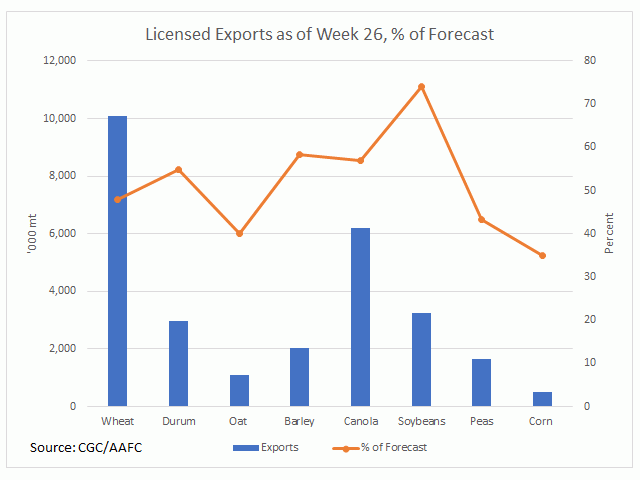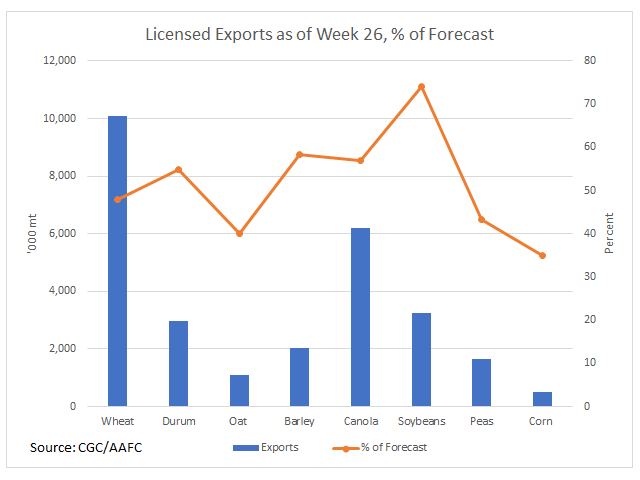Canada Markets
Statistics Canada December Agriculture Trade
Statistics Canada reports Canada's exports rising by 1.5% and imports falling by 2.3% in December, resulting in a drop in Canada's trade deficit from $3.6 billion to $1.7 billion. Exports of crude oil were up 10.5% from the previous month and refined energy products, largely diesel fuel exports to the U.S., were up 28.8%.
While the export of agricultural products was not mentioned in Statistics Canada's summary this month, exports for the broad farm, fishing and intermediate food products category were reported at $3.8507 billion for the month, which is a monthly record and largely due to the fast pace of movement of Canada's largest crops.
Here is a quick look at miscellaneous agricultural trade data, with a focus on grains and products not entirely captured in weekly CGC data.
Canada exported 165,230 metric tons (mt) of lentils in December, down for a second month but still the largest December exports in four years. The largest volume was shipped to Bangladesh at 26.6% of the total volume at 43,937 mt, with Turkey following at 30,589 mt or 18.5% of the total. This was the first month since December 2018 that India was not the largest buyer for the month. Year-to-date exports total 1.193 million metric tons (mmt), up 47.2% from the same five-month period in 2019-20 and 16.4% higher than the five-year average. AAFC reduced their 2020-21 export forecast by 100,000 mt in January to 2.8 mmt based on available supplies, while the current pace of exports is slightly ahead of the steady pace needed to reach this forecast.
Dry pea exports totaled 326,516 mt in December, up sharply from the previous month. China continues to dominate this movement with 84% of the total volume shipped to this country. Cumulative volumes after five months total 1.860 mmt, up 7% from the same period in 2019-20 and 17.8% higher than the five-year average. The pace of shipments is well ahead of the steady pace needed to reach the current 3.8 mmt forecast. At the same time, Statistics Canada has estimated Dec. 31 stocks of peas to be 3.6% lower than December 2019, which will also contribute to tighter-than-expected stocks at the end of the crop year, or July 31.
Canada's chickpea exports were reported at 8,890 mt, down from the previous month. Year-to-date exports are up 42,191 mt, up 9% from last crop year and 74% of the five-year average for this period. The pace of current movement is in line with the pace needed to reach the current 105,000 mt forecast by AAFC.
P[L1] D[0x0] M[300x250] OOP[F] ADUNIT[] T[]
Mustard exports totaled 10,443 mt in December, the largest monthly volume shipped in 14 months and the largest December movement in five years. The United States (42% of volume shipped) and Belgium (26.3%) continue to dominate shipments. Year-to-date exports of 45,420 mt represent 96.5% of the same period last crop year and 95.2% of the five-year average, while shipments are at a pace equal to the pace needed to reach the current 110,000 mt forecast. On Feb. 5, Statistics Canada estimated mustard stocks at 110,000 mt as of Dec. 31, down 24% from December 2019.
Canary seed exports totaled 12,752 mt in December, down sharply from the significant volume shipped in November. Cumulative exports are reported at 66,151 mt, up 25% from last year and 31% higher than the five-year average. AAFC increased their forecast for crop year exports by 5,000 mt in January to 160,000 mt, while the current pace of shipments is currently on track to meet this target. Statistics Canada estimated Dec. 31 stocks at 109,000 mt, up 2.8% year-over-year.
Canada's flax exports totaled 109,757 mt in December, the largest monthly volume shipped since December 2015. A reported 44% of this volume was shipped to Belgium and 38.8% of this volume was shipped to China, a large increase for both countries from the previous month. Exports as of December are shown at 241,525 mt, up 120% from the same period last crop year and up 28.4% from the five-year average. The current pace of movement is well ahead of the pace needed to reach the current 500,000 mt forecast. Statistics Canada has recently estimated Dec. 31 stocks at 377,000 mt, down 2.6% from the previous crop year, which will lead to further tightening of 2020-21 stocks.
Canada's soybean exports were reported at 877,979 mt in December, down from the previous month while the third-largest December shipments ever following December 2018 and 2019. The largest volume was destined for Iran in December at 157,183 mt or 18% of the total, while shipments this month were spread widely across 36 countries. China was the second-largest destination at 118,425 mt, a modest volume given this country's enormous demand.
Over the first four months of 2020-21, exports totaled 2.811 mmt, up 43.1% from last crop year while equal to the five-year average. This volume accounts for 63.9% of AAFC's 4.4 mmt forecast, well ahead of the steady pace needed to reach the current forecast. On Feb. 5, Statistics Canada reported estimated soybean stocks at 3.688 mmt as of Dec. 31, down 9% from one year ago, signaling a steeper drop in ending stocks than the 600,000 mt forecast by AAFC.
Canada's corn exports were reported at 209,575 mt in December, the largest monthly volume shipped in 19 months, with volumes increasing to 93,493 mt to Ireland, to 49,174 mt to the United Kingdom and 31,052 mt to Portugal. Year-to-date exports total 433,737 mt, up 366% from the same period last crop year and 26.5% higher than the five-year average. The cumulative pace of movement signals that 31% of the forecast 1.4 mmt of exports has been achieved, close to being on track to reach the current forecast tonnage.
In AAFC's January supply and demand forecast, the forecast for Canada's corn imports was revised by a significant 500,000 mt higher to 2 mmt. Cumulative imports over the first four months of this crop year total 517,438 mt, behind the steady pace needed to reach this forecast.
December statistics shows 307,426 mt of canola oil was exported, the largest monthly volume shipped in seven months. Cumulative exports total 1.359 mmt, which represents 99% of the volume shipped in the same period last crop year and 3% higher than the three-year average.
Canola meal exports totaled 465,234 mt in December, a significant volume and second to the 500,111 mt shipped in October. Cumulative shipments total 2.143 mmt over five months, 5.8% higher than the same period last year and 10.5% higher than the three-year average.
Canada's ethanol imports for December were reported at 82 million liters, the smallest volume imported in seven months. Total 2020 imports totaled 1.21 billion liters, down only .6% from the previous year and 5.1% below the three-year average.
Cliff Jamieson can be reached at cliff.jamieson@dtn.com
Follow him on Twitter @CliffJamieson
(c) Copyright 2021 DTN, LLC. All rights reserved.






Comments
To comment, please Log In or Join our Community .